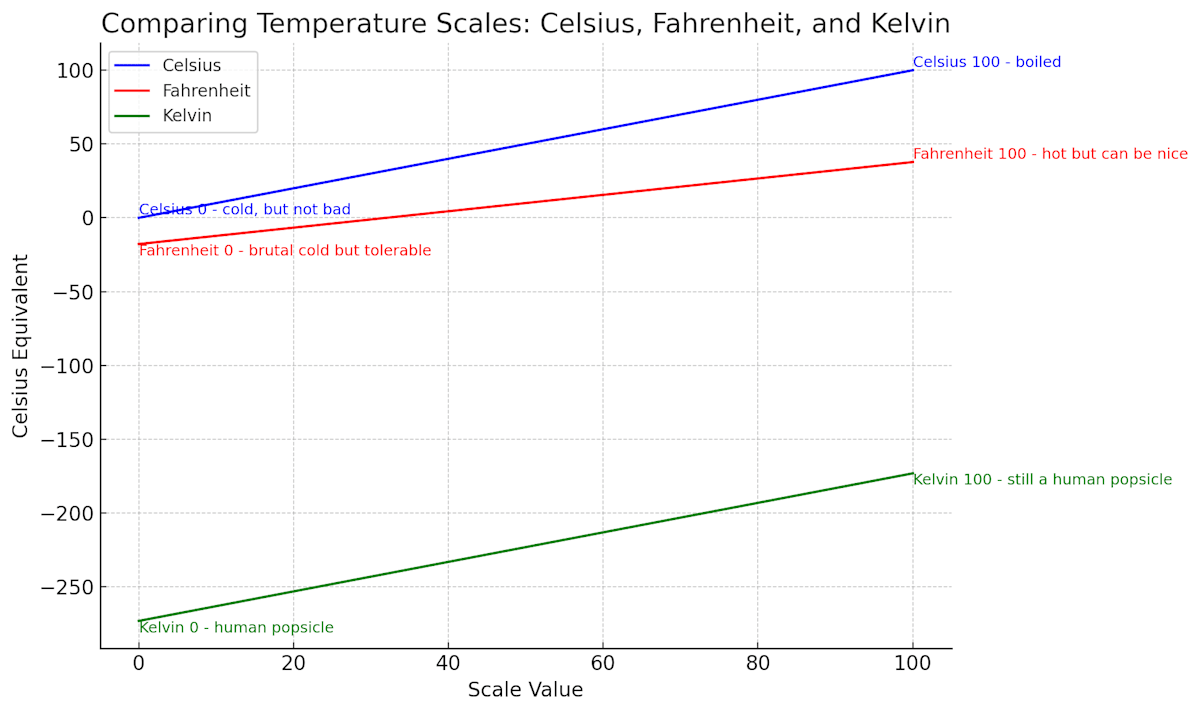The Tiny Slice of "Not Dying": How Useless Most of the Temperature Scale Is
Temperature is one of those things we think we understand because we complain about it constantly. “Ugh, it’s 90 degrees!” we groan, fanning ourselves. Or, “It’s 40 this morning, I can see my breath,” as if that’s some rare polar phenomenon instead of just a brisk Tuesday. But here’s the wild thing: almost none of the temperature scale is actually useful—or survivable—for humans. Like, not even remotely.
Let’s break it down.
The Human Tolerance Window
Humans are fragile meat popsicles powered by squishy chemical reactions. Those reactions work best in a very narrow band—roughly 35°C to 40°C (that’s 95°F to 104°F) internally. Your body starts to fall apart if it goes much lower or higher than that. Hypothermia? Get your body temperature around 30°C and dropping, you're in trouble. Hyperthermia? 41°C and you're cooking from the inside.
Outside temperatures have a slightly broader comfort zone, thanks to clothing and air conditioning. People can generally survive in environments from about -20°C to 50°C (-4°F to 122°F), but that’s with help. That’s assuming jackets, heating, shade, hydration, and the miracle of sunscreen. Start stripping away those supports, and our survival envelope narrows fast.
The Scales of Madness
Let’s talk numbers.
- Kelvin starts at zero—the absolute coldest anything can get, the total cessation of molecular motion. That’s -273.15°C. You die. Quickly.
- Celsius is a little more relatable. Water freezes at 0°C and boils at 100°C. That boiling point? That’s where proteins start to denature and everything you are ceases to function.
- Fahrenheit is a quirky little scale that mostly just makes weather sound more dramatic. But even here, once you dip below 20°F, things start to get real nippy. (I say this as someone from Maine who lives in Colorado—32°F is practically shorts weather.) On the flip side, anything over 100°F still feels like nature is trying to roast you alive.
Now let’s consider that Earth’s entire habitable range is between about -50°C and 50°C. That’s 100 degrees. In Kelvin, that’s a pathetic sliver between 223K and 323K.
The full Kelvin scale we use in science? It goes up past 5000K for stellar temperatures. The surface of the Sun is about 5778K. So when we say our comfort range is narrow, we’re not exaggerating—it’s less than 2% of the full temperature range we regularly measure.
The Rest of the Scale is Actively Trying to Kill You
Everything outside our narrow comfort zone is inhospitable at best, apocalyptic at worst.
- Temperatures above 60°C (140°F)? That’s approaching sterilization levels—great for killing bacteria, bad for people.
- Above 100°C (212°F), water doesn’t just boil, it superheats in the right conditions. Your eyeballs? Not a fan.
- Drop below -70°C (-94°F) and the air itself starts to burn your lungs. Even polar research stations don’t mess with that unprotected.
And that’s not even touching planetary-scale damage. Global temperatures rising just 2°C above pre-industrial levels is already wreaking havoc—melting glaciers, shifting weather systems, killing coral reefs. Push that to 4°C or more and you're talking ecosystem collapse, mass extinction, food shortages. The world doesn’t have to boil to be destroyed. Just a nudge in temperature is enough to destabilize everything we depend on.
Conclusion: We're Fragile, and the Universe is Hot (or Cold) Garbage
So yeah, temperature: we talk about it like it’s some universal, evenly distributed concept, but the truth is we live in a razor-thin slice of possibility. The rest of the scale? Utterly useless to us. Indifferent at best. Lethally hostile at worst.
In the grand scheme, we’re like that friend who only eats food between 70°F and 120°F—no hotter, no colder—and thinks anything else is “gross.” Except instead of food, it’s existence itself. And the universe? It’s mostly serving up scalding plasma or soul-freezing void.
Maybe next time you check the weather and complain about it being “a little chilly,” just remember: you’re in the miracle zone.
